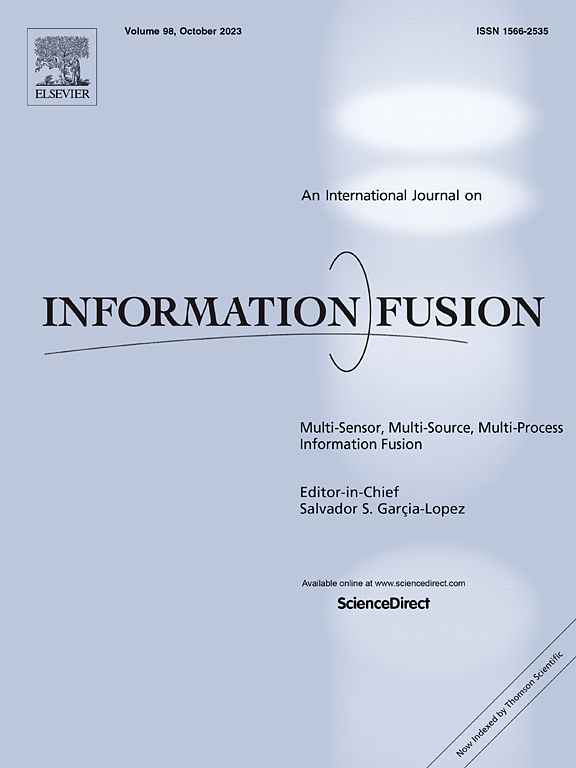BMCST:平衡多视图聚类与曼巴驱动的动态特征细化的空间分辨转录组学
IF 14.7
1区 计算机科学
Q1 COMPUTER SCIENCE, ARTIFICIAL INTELLIGENCE
引用次数: 0
摘要
空间解析转录组学(SRT)为空间聚类分析提供了组织学图像、空间位置和基因表达谱,为细胞相互作用和疾病进展机制提供了深刻的见解。尽管空间聚类研究取得了一定进展,但由于SRT数据固有的噪声和视图异质性,仍然存在一些主要挑战:①视图内:现有方法在建模点间全局依赖关系时容易忽略低质量或冗余特征的干扰,导致信息传播过多,计算冗余;(2)访谈视图:广泛采用的联合训练范式容易导致特定视图特征的不平衡和次优优化。为此,我们提出了一种新的SRT数据平衡多视图聚类方法,称为BMCST。具体来说,我们引入了一种状态自适应处理架构,即mamba驱动的动态特征细化(MDFR)模块,该模块根据输入的状态来动态选择并优先考虑视图内上下文中最具信息量的特征,而忽略噪声和无关信息。该策略确保了全面的全局建模,同时精确地捕获局部空间依赖关系。此外,引入无监督的主导视图挖掘机制,在特征融合过程之前动态识别最具判别性的视角,并结合优化的视图间对齐和节点间一致的相似度分布,旨在缓解视图间信息不平衡。大量实验表明,所提出的BMCST在空间域识别方面优于其他最先进的方法。本文章由计算机程序翻译,如有差异,请以英文原文为准。
BMCST: Balanced multi-view clustering for spatially resolved transcriptomics with Mamba-driven dynamic feature refinement
Spatially resolved transcriptomics (SRT) provides histological images, spatial location, and gene expression profiles for spatial clustering analysis, offering profound insights into cellular interactions and disease progression mechanisms. Despite the progress made in spatial clustering research, several primary challenges persist due to the inherent noise and view heterogeneity in SRT data: (1) Intra-view: existing methods are prone to overlooking the interference from low-quality or redundant features when modeling global dependencies among spots, which leads to excessive information propagation and redundant computations; (2) Inter-view: the widely adopted joint training paradigm tends to result in an imbalance and suboptimal optimization of view-specific features. To this end, we propose a novel balanced multi-view clustering method for SRT data, referred to as BMCST. Specifically, we introduce a state-adaptive processing architecture, the Mamba-driven Dynamic Feature Refinement (MDFR) module, which adapts to the state of the input to dynamically select and prioritize the most informative features within the intra-view context, disregarding the noise and irrelevant information. This strategy ensures comprehensive global modeling while precisely capturing local spatial dependencies. Additionally, an unsupervised dominant view mining mechanism is introduced to dynamically identify the most discriminative perspectives prior to the feature fusion process, coupled with optimized alignment among views and consistent similarity distributions between nodes, aiming to mitigate inter-view information imbalance. Extensive experiments show that the proposed BMCST outperforms other state-of-the-art methods in spatial domain identification.
求助全文
通过发布文献求助,成功后即可免费获取论文全文。
去求助
来源期刊

Information Fusion
工程技术-计算机:理论方法
CiteScore
33.20
自引率
4.30%
发文量
161
审稿时长
7.9 months
期刊介绍:
Information Fusion serves as a central platform for showcasing advancements in multi-sensor, multi-source, multi-process information fusion, fostering collaboration among diverse disciplines driving its progress. It is the leading outlet for sharing research and development in this field, focusing on architectures, algorithms, and applications. Papers dealing with fundamental theoretical analyses as well as those demonstrating their application to real-world problems will be welcome.
 求助内容:
求助内容: 应助结果提醒方式:
应助结果提醒方式:


